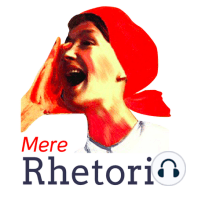12 min listen
Four Master Tropes (NEW AND IMPROVED!
FromMere Rhetoric
ratings:
Length:
10 minutes
Released:
Dec 2, 2015
Format:
Podcast episode
Description
Welcome to Mere Rhetoric the podcast for beginners and insiders about the people, ideas and movement that have shaped rhetorical history. I’m Mary Hedengren and the University of Texas’ Humanities Media Project supports the podcast and
A few weeks ago I was at an excellent lecture by Collin Brooke here at the university of Texas and he was talking about applying the master tropes to different models of networks. Then I thought--by Jove, the Master Tropes! What a brilliant idea for a podcast! So with all deference to Dr. Brooke, let’s dive into these four beauties of the world of tropes.
A trope, you may or not know, is a way of presenting thought in language. A trope is different from what’s called a figure because it doesn’t deal with arranging words, but rather arranging thought. For example, a figure might be something like hyperbaton, which is the the way that Yoda talks: “Patience you must have” just means “you must have patience” there’s not change in the thought behind the words, but the refiguring of the words creates interest, so Yoda says things like “Miss them do not” instead of do not miss them, but the ideas aren’t changed at all. That’s figures.
Occasionally, though, Yoda will use a trope. For example, once he said ““In a dark place we find ourselves, and a little more knowledge lights our way.” This is, as it turns out, a metaphor: knowledge doesn’t actually cast a glow, but it does make things metaphorically clear. The words transform the ideas: light equals knowledge. It’s not that Yoda changed the words around--all considered this is pretty syntactically straight-forward for the sage-green sage--but he’s presented the ideas in a different way. This is a trope, not a figure.
It is, as a matter of fact, one of the four master tropes: Metaphor, Synecdoche, Metonymy and Irony. It’s possible that these terms aren’t familiar to you, or only in a vague, AP English sort of way, so let me provide examples and definitions. Metaphor is the trope that is most familiar to us: knowledge is light, the Force is a river, many Storm troupers are a wall. So I’m going to skip over that. Synecdoche is--aside from being difficult to pronounce, using the part to represent the whole. I always think of that movie Synecdoche New York, where the guy builds a replica of New York for a movie. The standard examples include things like “earning your bread and butter” when you’re hopefully earning much more than that or “putting boots on the ground” when the military often needs soldiers, too, to fill those boots. I used to joke with my Mormon comedy group since everyone prays to “bless the hands that prepared this food,” if there was a terrible accident in the kitchen and everyone died, at least the hands would be preserved. So you get the idea. Metonymy can sometimes be a little more confusing, because it, like Synecdoche, involves using a word associated with the idea to stand in for the idea itself. We say things like “the White House has issued a statement” when the building itself has done no such thing, or “Hollywood is corrupt” to represent the movie business generally. Some people will say that synecdoche is just a specific kind of metonymy, like how simile is a specific kind of metaphor. Finally, irony may seem like a simple, straightforward trope, but it can be notoriously complex, as Wayne Booth describes in greater detail in The Rhetoric of Irony. How we we know when someone is being ironic? How much is irony dependent on understanding cultural cues? Why do we say the opposite of what we mean as a way to say what we want? Tricky stuff all around.
The four master tropes are probably most familiar to rhetoricians as the essay found way in the back of Kenneth Burke’s Grammar of Methods, way way back as an appendix. There, Burke equates these over-arching tropes with different epistemic perspectives: metaphor correlates with perspective, metonymy with reduction, synecdoche with representation, and irony with dialectic.
Released:
Dec 2, 2015
Format:
Podcast episode
Titles in the series (99)
Ekphrasis (NEW AND IMPROVED: Ekphrasis Welcome to Mere Rhetoric, a podcast for beginners and insiders about the ideas, people and movements who have shaped rhetorical history. I’m Mary Hedengren and, ah, here I am in my newly redecorated research cube. I’ve taped... by Mere Rhetoric
